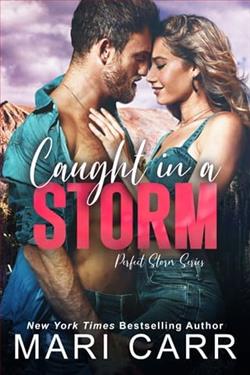Page 7 of The Sky Beneath Us
The curator introduced us. ‘Miss Mackenzie-Grant, I believe you have already encountered Callum Gillespie. He speaks highly of your artistic skills, and it was on his recommendation that I approached Miss Morison to see if we could avail ourselves of your services.’
Regaining my composure, I replied, with what I hoped sounded like calm professionalism, ‘Our paths have crossed on occasion whilst at work in the gardens. It is a great honour that my drawings might be considered of a standard to help catalogue the new arrivals here.’ I cast a look around the room, meeting the glances of other men who had paused in their work, disturbed by the arrival of a female interloper.
Dr Kay nodded. ‘Very good. Well, I’ll leave you in the capable hands of Mr Gillespie. He can make some space and show you the specimens we’ve set aside for drawing.’
I thanked him and then set my satchel on a stool alongside the workbench, unbuttoning my coat and removing it ready to roll up my sleeves and set to work.
‘You can hang that on one of those hooks over there.’ Callum pointed towards the door and then began stacking several of the thick card folders that were scattered over the worktop one on top of the other, clearing one end of the bench.
Perched on my stool, I listened carefully as he showed me how each specimen was processed. ‘These crates are a bit like a lucky dip. You never quite know what you’re going to pull out next. And you never know what state the plants might be in, either. Some are useless, mouldy and rotted by seawater, and have travelled all this way only to end up as compost. Others are so perfectly preserved they almost still show signs of life. But most are like this rhododendron here’ – he picked up the dry branch he’d been working on – ‘and whilst we have enough to go on to catalogue them and preserve them in the Herbarium, sometimes a bit of artistic interpretation helps bring them back to life. That’s where you come in.’
He passed me a pile of folders. ‘These will get you started. They’re well annotated, so it should be fairly easy for you to get the colours right. See, here, someone’s written this lily is “the colours of the sunrise”. Other specimens will need a bit more detective work asthe notes are a bit sketchy. You’ll need to look up similar species in the books we have to get more accurate clues as to what the flowers look like in the wild.’
I opened the first folder, revealing a pressed rhododendron bloom. The sheet of paper on which it had been stuck carried the official stamp of the Botanic Garden as well as a number of neat, handwritten notes detailing the location and date of collection and the name of the collector: G. Forrest.
Callum must have seen the awe in my expression when I read the name because he moved a little closer to look over my shoulder. ‘Pretty impressive, isn’t it?’ he said, his hazel eyes alight with enthusiasm. I’ve noticed they seem to shift from brown to green to golden, depending on the light and his mood. ‘To think, George Forrest himself clambered up some rocky slope somewhere on a Himalayan mountainside and picked this. See here, the altitude is recorded too. Twelve thousand feet. Just imagine being part of an expedition that takes you to such places, finding plants like this one that haven’t been seen in the world beyond those mountains!’
I found myself smiling back at him, swept up in his passion as he described some of the other specimens he’d been working on from that same expedition. The whitewashed walls of the hall seemed to melt away, replaced by the landscape he described. Soaring mountain peaks, covered in snow and far higher than anything we have in Scotland, appeared against a dizzyingly blue sky. I felt a little breathless, imagining the effort of trekking in the thin, cold air and the wildness of the places where banks of these miraculous coral-coloured flowers blanketed the inhospitable terrain.
‘These are my favourites, I think. We’ve just received them from Colonel Fairburn’s latest expedition to Tibet.’ He pushed another stack of folders my way and I opened the cardboard cover to find a beautiful pressed blue flower on a slender stem. ‘Meconopsis– the Himalayan blue poppy. Aren’t they extraordinary?’
‘Extraordinary,’ I echoed. ‘Lilies the colours of the sunrise. And poppies the colour of sky.’
I’d seen flowers like this one before, because Mrs Hanbury has begun cultivating them at Inverewe. They seem to thrive in the damp but temperate climate there, moderated even in winter by the Atlantic’s Gulf Stream current. In May, their sky-blue petals glow against the woodland backdrop, nodding on tall stems as they stir in the ocean breeze. When I told him that, he said, ‘I’d love to see the garden at Inverewe one day. I hear it’s full of wonders that cannot be grown in other parts of Scotland.’
‘Well, maybe one day I can show you round,’ I replied. There was a moment’s silence and in it I realised something had shifted between us. His gaze, which had seemed awkward and confrontational on our previous encounters, suddenly felt like the sun coming out from behind a cloud on a spring day. He must have felt it too – perhaps my own eyes were shining with the same light – because he blushed and turned away, busying himself with setting the piles of folders back in place.
‘Right, well,’ I said, as businesslike as anything, ‘I’ll get on with it then.’ I set out my drawing things, opening the tin box holding my brushes. I took out the little carving of the palmetto frond that he’d dropped at my feet those weeks before. ‘I never had a chance to thank you for this, by the way.’ The wooden leaf nestled in my hand, and I curled my work-roughened fingers around it.
His cheeks flushed a deeper red and he seemed stuck for words.
‘I think I owe you an apology too,’ I went on quietly, not wishing the others around us to overhear. ‘That day we first met, in the Palm House. I didn’t realise you were a gardener. I must have seemed awfully condescending, lecturing you on the provenance of the plants you tend. I was sorry I drove you away.’
‘Aye, well, perhaps I should have introduced myself properly. It’s a warm spot to sit on a Sunday when the east wind’s blowing.The room in my digs catches the draught full on and the Palm House makes a good refuge. But there’s no harm in sharing it with others.’
I felt all the worse, realising it was probably one of the few places he could go to get warm on his day off that didn’t involve having to find the cost of a cup of tea.
‘Perhaps another time you could show me round,’ I said, opening my sketch book and picking up my pencil. ‘I’m sure there’ll be plenty more cold and damp Sundays ahead of us in the winter months.’
He didn’t reply, and we set to work in companionable silence on the specimens before us. As I mixed my watercolours, attempting to make exactly the right shade of cherry red to bring my sketch ofRhododendron barbatumto life, I heard him whistling faintly under his breath. And I couldn’t be sure, but I think the tune just might have been a song I’d once heard about a bonny lass and the man who loved her.
Daisy – March 2020
I have two more days in Kathmandu to prepare for trekking in the mountains. Top of my list of priorities is to lay my hands on some pills to help with altitude sickness and a supply of loo rolls. Apparently, the former are readily available but the latter are scarce in the more remote parts of Nepal and I’m worried about the possibility of them being suddenly and catastrophically needed. We’ll be staying a day or two in Namche Bazaar, to acclimatise to the change in altitude. My guidebook warns that everything is available there but at greatly inflated prices. Every single item has to be carried up to the hill town – one of the main waystations on the trek to Everest Base Camp – on the backs of porters and mules.
Ironically, when I return to the hotel in the evening with my booty, a BBC news update on my phone describes a severe shortage of toilet paper in the UK as a result of panic buying, so I take a photo of the two rolls I’ve managed to buy in Kathmandu and send it to Jack with a message saying,Eat your heart out!
He must be within reach of shore somewhere because a text pings back almost straight away:Did you know that an anagram of HEART is HATER? Bog paper situation not yet critical here. But good to know I can call on you in case of dire emergency.
Where are you?I ask.
Bought a boat in Bermuda. She’s a beauty. Called Skylark. The name reminded me of you, Laverocks, it being the Scots word for a lark and all, so I knew she had to be mine the minute I saw her. Now anchored off Grenada. Turned away at every port. Attempting to reprovision and then going to make for the Azores. Might as well do lockdown crossing the Atlantic.
On your own??
What could possibly go wrong?He adds a laughing face emoji.
Take care, I text back.















